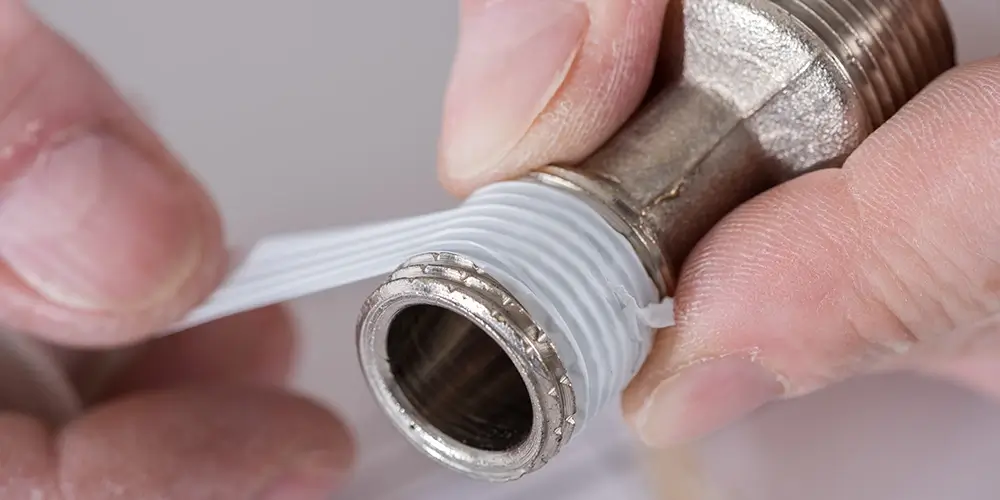Bummer.
There’s a leak in the line connecting the toilet to your home’s water supply.
A visual inspection reveals that the problem is caused by the threaded connection between the water line and the bottom of the toilet tank.
Or the problem may lie with the threaded connection at the other end, between the supply line and the shut-off valve at the wall.
Those threaded connections! What’s a resourceful DIYer to do? Run to the hardware store and waste an afternoon searching for replacing leaky connectors?
Not when there’s Teflon tape lying about, an indispensable tool for any homeowner with more than a modicum of DIY repair ability.
It can certainly stop the leak, but you have to know how to apply it.
This blog will list the steps.
What Is Teflon Tape?
Teflon tape, or “plumber’s tape,” is a thin, flexible white strip of polytetrafluoroethylene (PTFE). It works like a thread sealer, with a friction-resistant surface that creates an airtight connection between two threaded pipes.
For legal reasons, only the DuPont Corporation can use the Teflon name. However, most people refer to all PTFE tape as “Teflon,” regardless of its origin, the way all hot tubs have become “Jacuzzis.”
Teflon isn’t just for cooking, medical appliances, and waterproof fabric! No self-respecting plumber would be without it.
Several properties of Teflon tape make it ideal for waterproof seals in threaded pipe connections.
- Great flexibility
- Great strength and resistance to tearing
- The thinness to fit into tight spaces.
Teflon tape acts like putty without the putty mess and inconvenience. Under the squeezing forces of a male and female connection (yes, we’re still talking about plumbing), it spreads out and fills the gaps between the threads. This action prevents water — and air, for that matter — from passing through the connection and causing a leak.
How to Apply Teflon Tape for a Watertight Seal
However…
Teflon tape won’t do the job if misapplied. So here’s a step-by-step guide to fixing your leaky toilet supply line:
- Dry the threads of each connection, and clean the threads on the male connector of any debris.
- Wrap the male connector with Teflon tape. Loop twice at the lower end of the threads and work your way up, but don’t go past the end of the connector. It’s almost like regripping a tennis racket!
- Tape inside the joint can cause clogging and other problems. Overlap each loop by about half of the tape’s width.
- Follow the direction of the threads while wrapping. Keep the tape under tension as you wrap. Loosely wrapped tape will shift when you screw the connections together.
- After the last circuit, cut the tape and press the loose end into the connector’s threads. Nothing should protrude from the threads’ surface.
- Insert the male connector into the female connection. Screw it in by hand and finish the job with a wrench. No jokes, please.
Plumbing professionals often use Teflon pipe compound to make the joints extra-secure. If you go this route:
- Use your finger to apply a thin, even compound coating over the surface of a male connector already covered with tape. The compound usually comes in a squeezable tube.
- Screw the connection together and tighten it with a wrench.
But What If My Toilet Still Leaks?
Now, suppose you did all the work and followed our guidelines exactly, but the toilet’s still leaking.
Other problems, including loose nuts at either end of the line, can trigger leaks in your toilet’s supply line.
So you’ll need to address each problem as it arises, or you may throw in the towel and call a professional plumbing service. DIY repairs will get you only so far; a leaky toilet can cause massive damage if not fixed promptly.
When in doubt, call Orange Coast Plumbing.
FAQs: Using Teflon Tape for a Leaky Toilet
Q: How does Teflon tape work?
It creates a watertight seal between threaded pipes and fittings, filling in gaps or imperfections. This prevents leaks from reocurring.
Q: Is Teflon tape the same as pipe joint compound?
Pipe joint compound is a paste-like substance applied to threaded pipes and fittings before they’re screwed together. It serves a similar purpose as Teflon tape but isn’t the same. Teflon tape is a thin, flexible film wrapped around the threads of pipes and fittings to create a seal.
Q: Can I use Teflon tape on any pipe?
It can be used on almost any type of pipe material, including PVC, copper, and galvanized steel. However, you should check the manufacturer’s instructions before applying Teflon tape on other materials.
Q: How long does Teflon tape last?
The lifespan varies, depending on the quality of the tape and how it’s used. On average, it can last for several years if properly applied and not exposed to harsh chemicals or extreme temperatures.
Q: Is Teflon tape reusable?
No, Teflon tape should be replaced whenever you disassemble and reassemble a joint.
Q: When should I use Teflon tape on my toilet?
Apply Teflon tape to your toilet’s threaded connections, such as the water supply line and the bolts that connect the tank to the bowl, when installing a new toilet or fixing a leak in these areas.
Q: Can Teflon tape be used on all types of toilets?
Yes. It’s suitable for all types of toilets, regardless of their design or material. Its primary function is to seal threaded connections.
Q: How much Teflon tape should I use?
Wrapping the tape around the thread 3–4 times is usually enough to create a secure seal. However, if the gap seems larger or the fitting is old, you might need to add an extra wrap or two for a better seal.
Q: Is it possible to use too much Teflon tape?
Too much Teflon tape can make it difficult to screw the parts together and could potentially worsen the leak by preventing a secure fit. Stick to 3–4 wraps and adjust if necessary.
Q: Can Teflon tape fix all types of toilet leaks?
Teflon tape is effective for sealing leaks at threaded connections, but not for toilet tank or bowl cracks. Those leaks require different repair methods or replacement parts.
Q: What are the common mistakes to avoid when applying Teflon tape?
Avoid wrapping the tape in the wrong direction, using too much or too little tape, and not cleaning the threads before application. These mistakes could worsen the leak.
Q: Do I need to replace Teflon tape regularly?
No, Teflon tape doesn’t degrade under normal conditions. However, if you disassemble a connection for any reason, remove the old tape and apply a fresh layer.
Q: Is Teflon tape safe for potable water connections in toilets?
Yes. Teflon tape doesn’t react chemically with the water, thus posing no health risks.
Q: What should I do if the toilet leaks after applying Teflon tape?
Verify that the tape has been applied correctly and to the right parts. Call a professional plumber to diagnose and repair the leak if the issue persists.


